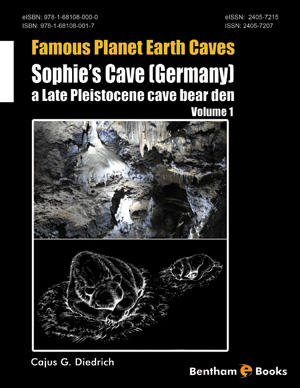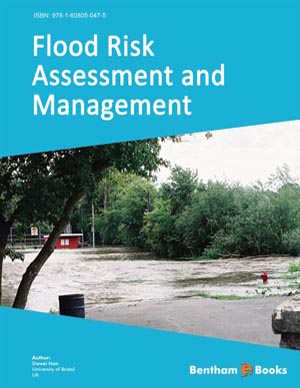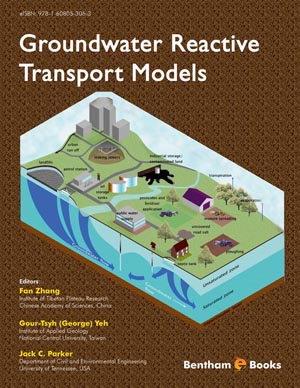Introduction
Page: 3-25 (23)
Author: Cajus G. Diedrich
DOI: 10.2174/9781681080000115010005
PDF Price: $15
Abstract
The Sophie’s Cave (Bavaria, Germany), is one of the oldest show caves in Germany, and even one of the famous Late Pleistocene cave bear den caves in Europe. The cave is situated with several other famous and larger cave bear den caves, such as the Zoolithen Cave and Große Teufels Cave (latter also show cave) in one of the most cave-rich regions of Germany, the Franconia Karst especially along the Wisent and Ahorn River valleys. The confusing names of the “Rabenstein Cave” (because of its close topographic situation to the Rabenstein Castle), and later named Sophie’s Cave cave parts were renamed systematically. Along the historical wooden steps and trail several sherded ceramic lamps and pottery pieces were found, which are from the “oldest cave lighting system” known in a German show cave reaching back to its discovery in 1833. After the first report of the cave by the German priest Esper in 1774, several famous European natural scientists such as Rosenmüller, Goldfuss, Graf zu Münster, Buckland and Sternberg collected or started to describe first bone finds from the first discovered cave parts, which material went partly to Prague, Bayreuth or are lost. The youngest historical finds which seem to be in connection with the visitor show cave are few militaria from the King Ludwig I (1825-1848) regentship time.
Geology of the Cave Rocks in Upper Franconia
Page: 26-33 (8)
Author: Cajus G. Diedrich
DOI: 10.2174/9781681080000115010006
PDF Price: $15
Abstract
The white-yellowish, massive Upper Jurassic dolomite reef rocks (155-150 My) of Upper Franconia are famous for climbers, because of its rich cavities, partly caused initially by burrowing marine crustaceans (= Lochkalke), partly due to rockweathering and cave erosion. It is one of the most cave-rich regions in Europe counting several hundreds of mainly smaller caves, and few very large cave systems. Those are situated on the Upper Franconia Plateau, which is cut by the Wiesent and smaller branching river valleys. The Late Jurassic fossils (ammonite steinkerns, and metasomatic changed silified and originally calcite reef fossils) found within Pleistocene sediments of the Sophie’s Cave supports reconstructing the Pliocene plateau and Pleistocene valley erosion history and geomorphological changes in the surroundings.
Plio- to Middle Pleistocene Sedimentology, Cave Genesis and Ailsbach Valley Geomorphology
Page: 34-53 (20)
Author: Cajus G. Diedrich
DOI: 10.2174/9781681080000115010007
PDF Price: $15
Abstract
The Sophie’s Cave in southern Germany, in the middle high elevated (max 550 m a.s.l.) mountains of northern Bavaria, was formed by Pliocene subsurface ground waters of the Upper Franconia Jurassic Plateau (about 440 a.s.l.). In the ponor cave stage of Early Pliocene age, the horizontal system which started to refill partly with about 3-4 m iron-and manganese-rich clays and dolomite ash sands (= coloured series). Within the intermediate cave stage in the Early-Middle Pleistocene, the Ailsbach River valley lowered from 440 to 420 m a.s.l. In the Middle Pleistocene, fluvial sediment intruded only from the valley side into the Sophie’s Cave from above the Clausstein Hall vertical shaft consisting of 8 m thick river terrace clay, sand and gravel (= “yellow series”). A first Middle Pleistocene (?Holsteinian Interglacial) speleothem generation formed on the top. Middle Pleistocene marten Martes sp. used some parts at minimum in the Clauststein Hall as a den and left some tracks on muds being the first known Middle Pleistocene footprints named herein Martichnus desseri nov. ichnogen. and ichnosp. in Europe, which were casted and preserved by the speleothem layer. These Middle Pleistocene cave sediment and speleothems eroded somehow within the late Middle Pleistocene (?Saalian) in the valley sided cave branches by intruding floods.
The Early/Middle Late Pleistocene Cave Bear Den
Page: 54-84 (31)
Author: Cajus G. Diedrich
DOI: 10.2174/9781681080000115010008
PDF Price: $15
Abstract
With the beginning of the early Late Pleistocene glacial period (or even earlier: ?late Saalian/Eemian) and Ailsbach terrace elevation 415 m a.s.l., small cave bears penetrated only a side branch (Bear’s Passage) the Sophie’s Cave and used it as den. Nine cave bear nests Ursalveolus carpathicus Diedrich 2011 were documented with larger to medium-sized round-oval depressions in the deepest cave bear den part of the Millionary Hall. Autochthonous cave bear skeletal parts, especially partly connected vertebral columns were found in all den areas of the Bear’s Passage, Reindeer Hall bone field and the Millionary Hall, partly being in place. A systematic excavation of the bone field, which was left in the cave in situ (also for visitors) demonstrate a mainly adult population within this hall. Using a combination of the skull shape morphology, P4 tooth morphology and C14 dated teeth from other German/European cave bear dens, the small cave bears of those cave areas can be identified as small cave bears U. spelaeus eremus/spelaeus Rabeder et al. 2004. A new composite skeleton including male/female adult-senile bone material from different individuals was arranged for “U. s. cf. eremus” which is presented in a show case within the cave, which is anatomically nearly complete including in Europe unique for a “skeleton” all nine “tongue bones”. These small cave bears also being known from the nearby Große Teufels Cave, Zoolithen Cave inhabited in Upper Franconia the Sophie’s Cave and other caves between approx. 113.000-32.000 BP dated biostratigraphically with the P4 tooth morphology. With the P4 morphotypes blocking events can be coarsely estimated, whereas most primitive three-coned forms appear in the deeper Millionary/Reindeer halls and Bear’s Passage. Only in the latter higher evolved forms demonstrate a longer use of this branch which was blocked to the Reindeer Hall most probably during an interstadial (possibly around 42.000 BP). At the end of the middle Late Pleistocene, finally the former still unknown entrance was also blocked, which did not allow smaller cave bears to use the cave as a den anymore.
Lion, Hyena Wolf, Weasel and Porcupine Cave Dwellers - Cave Bear Killers and Scavengers
Page: 85-111 (27)
Author: Cajus G. Diedrich
DOI: 10.2174/9781681080000115010009
PDF Price: $15
Abstract
In the early/middle Late Pleistocene, when the small cave bears U. s. eremus/spelaeus Rabeder et al. 2004 used a part of the Sophie’s Cave as den, different large and small carnivors were mainly cave dwellers or short-time occupants. With the beginning of the Late Pleistocene glacial period (113.000 BP, terrace elevation 415 m a.s.l.), Ice Age wolves used one area in the cave as a den at the end of the Bear`s Passage. Canis lupus spelaeus Goldfuss 1823 being represented only by grown up animal bones left larger amounts of phosphatic excrements in the cave bear bonebed especially in the Bear’s Passage, but up to the Millionary Hall. A high percentage of about 26% of the cave bear bones have large predator bite damages. Mainly Ice Age wolves and Ice Age spotted hyenas scavenged the small cave bear subspecies carcasses. They produced larger bite damages on the vertebral column (inner side) proving an initial intestine/inner organ feeding. Steppe lions hunted cave bears even deeper in the cave where cave bears hibernated, whereas this can not be proven, only indirectly on large canine bite marks, which also might have resulted from those felids. Some cave area (also especially Bear’s Passage) was used as a weasel Mustela erminea Linnaeus 1758 den, whereas the Ice Age porcupine Hystrix (Acanthion) brachyura Linnaeus 1758 dwelling is proven indirectly again only in the Bear’s Passage with typical large rodent bite marks on two cave bear cub humeri. At the end of the middle Late Pleistocene, the former still unknown Bear’s Passage entrance was blocked, which did not allow the smaller cave bears, carnivores or porcupines to penetrate the cave anymore, all inhabited/dwelled only a cave branch between approx. 113.000-32.000 BP.
The Final Late Pleistocene Cave Bear and Sporadic Carnivore (Hyena And Wolf) Den
Page: 112-145 (34)
Author: Cajus G. Diedrich
DOI: 10.2174/9781681080000115010010
PDF Price: $15
Abstract
About 32.000-26.000 BP the largest cave bears Ursus ingressus Rabeder et al. 2004 used the Sophie’s Cave such as other larger cave bear dens of the Zoolithen Cave, Große Teufels Cave and Geisloch Cave and others in Upper Franconia. At this time the large portal of the today’s entrance was opened. In this hall and branching areas, the cave was used for denning and birth. The Ailsbach River terrace changed first with an elevation increasing that caused periodical floods of the anterior valley oriented cave part only. Within the partly dry cave, seasonal floods cleft two more fluvial sequences, which are dominated in the first stage by sands and gravels. In the last stage, “gravel/frost brekzia/glauconite sand till series” of the latest Late Pleistocene and around the LGM (app. 32.000-16.000 BP) the floods finally transported sediment and the bones only into the Ahornloch branching halls and Passages. The large cave bears were also scavenged and predated by the three top predators (lions, hyenas and wolves) that specialized especially in boreal forests on cave bear feeding as a result of rare and disappearing valley migratory mammoth steppe game. Hyenas used the Sophie’s Cave only shortly as den in the Ahornloch Hall area and imported typical for cave dens in Europe some woolly mammooth Mammuthus primigenius (Blumenbach 1799), woolly rhinoceros Coelodonta antiquitatis (Blumenbach 1799), and Equus caballus przewalski Poljakov 1888 horse prey remains into the cave entrance halls, which bones show typical hyena caused bite/chew damage. Already before the climatic change not later then 24.000 BP, before the Last Glacial Maximium glacier extensions in Europe (LGM, 19.000 BP), with unsolved questionable “glacial signs” (?valley glaciers) in Upper Franconia and within the Sophie’s Cave, caused the extinction of the last cave bears, their top predators, and most of the boreal forest megafauna in Upper Franconia and central Europe.
Late Pleistocene Archaeology
Page: 146-158 (13)
Author: Cajus G. Diedrich
DOI: 10.2174/9781681080000115010011
PDF Price: $15
Abstract
The Sophie’s Cave was used during the last dry cave stage just before the maximum glaciation by the first modern humans, Late Palaeolithic Early Gravettian reindeer hunters, but not as short-term hunting camp or or settlement, but as shamanic sanctuary. Those hunters seem to have deposited year after year selected larger male shed reindeer antlers (one C14-dated 30.830-30.340 cal. BP) in only one of the deeper chambers of the cave, possibly also two mammoth pelvic halves (one C14-dated 29.340- 28.600 cal. BP) and other bones of the megafauna. Already before the Last Maximum Glaciation (= LGM, around 19.000 BP) humans and the cave bear boreal fauna disappeared in the Franconia Karst region, similar as all over Central Europe. The valley was resettled by the last reindeer hunters at the end of the glaciation by Epipalaeolithics, which left remains in other smaller cave entrances or rock shelters in lower elevations along the Wisent and Ahorn valleys.
Main Post-LGM Speleothem Period
Page: 159-169 (11)
Author: Cajus G. Diedrich
DOI: 10.2174/9781681080000115010012
PDF Price: $15
Abstract
Within the climatic change after the LGM to the final Ice Age interstadials and stadials changed with humid and dryer periods. A strong “cave ceiling collapse” throughout the cave within this time frame blocked some passages up to the Collapse Hall. Most of the candle stalagmites were formed in this time between 16.000-12.000 BP with the last and main speleothem genesis, which continues since the Holocene. The cave floor was covered especially in the larger halls by falling large blocks which scattered the reindeer antlers in the Reindeer Hall, but also closed the connections of the chambers/halls in the middle part of the cave. Between those, and on those, a variety of different speleothem types formed, whereas the largest are found within the Millionary Hall. Sinter basins are also found there and in the connected Reinder Hall, only. After all sedimentological, stratigraphic, and cave bear clock dating methods, nearly the complete large “sinter decoration” of the Sophie’s Cave must have build up in the middle to late Late Pleistocene covering the cave bear skulls/bones of U. spelaeus eremus/spelaeus and U. ingressus and their bonebeds all over in a second larger speleogenesis time starting in a warmer interstadial around 42.000 BP (Millionary after Chapter 3) and a third final main speleogenesis time around 16.000- 12.000 BP in the Alleroed to Dryas which continued since the Holocene.
Postglacial Archaeology
Page: 170-174 (5)
Author: Cajus G. Diedrich
DOI: 10.2174/9781681080000115010013
PDF Price: $15
Abstract
Postglacially, humans used the entrance throughout the Urnenfeld Bronze Age into the Hallstadt/La Tène Iron Age, which is documented by pottery shards. The lower cave entrances were occupied intensively at the Early Medival times during which the castle was built 30 meters above the cave entrance on the Jurassic dolimite plateau. From this time period, few animal and human bones such as iron/bone/stone tools and bone kitchen rubbish and several pottery shards were found on the yard infront of the today’s cave entrance and the lower cave part entrance areas.
Modern Cave Animals and Guests
Page: 175-179 (5)
Author: Cajus G. Diedrich
DOI: 10.2174/9781681080000115010014
PDF Price: $15
Abstract
Today, some possibly endemic cave animals inhabit or use seasonally different parts of the cave system, which is still in use as a common fox den reaching hereby deeper cave parts of the lower cave system. Common cave spiders (Meta menardi) or moths (Triphosa dubitata) such as rare bats (Myotis myotis) use only the larger first two halls of the cave entrance area, whereas bats are rarely found for hibernation only deeper in the cave. In the middle part of the cave, water bodies of the speleothem terrace basins contain possibly endemic small crustaceans (Bath-ynella), in the mud infaunistic pigment and eye-less flatworms (Phagocatta) or on the water surfaces springtails (Heteromurus/Onychiurus), which species are not yet determined.
Introduction
Famous Planet Earth Caves - The new series presents important caves or rock shelters in any kind of rock types all over the world. Each book focuses on a single cave presentation covering different and most important disciplines of a cave: Geology (e.g. cave genesis, sedimentology, speleothems) such as Hydrogeology (e.g. speleothems for climate reconstructions, aquifer reconstructions), Paleontology (e.g. cave bear or carnivore dens), Archeology (e.g. Palaeolithic to Medieval camp or burial sites) and modern Biology (e.g. bat caves). The books are scientific chaptered monographs, sometimes of show caves, but often of non- or difficult to access caves. The well-illustrated books are written in a mixed scientific and popular scientific way for a better understanding and larger readership, especially speleologists and natural scientists all over the world.











